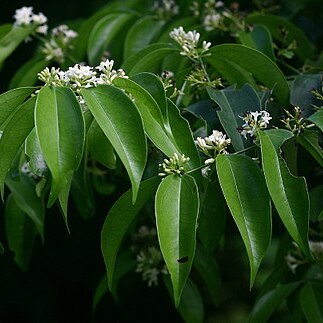Corolla in the mature bud 3–4 times as long as the calyx, 2–3·5 mm. long, and rounded at the apex, white, yellow, or sometimes orange, glabrous or minutely papillose–pubescent outside, inside with a ring of hairs in the throat and often, when outside so, minutely papillose–pubescent on the lobes; tube short, urceolate, 1–1·4(1·7) times as long as the calyx, 1–1·4 mm. long; at the throat 1·4–2·2 mm. wide; lobes 1·4–1·6(2·7) times as long as the tube, oblong, 1·3–2·2 times as long as wide, 1·2–2·2 x 0·8–1·3 mm., acute, recurved from somewhat below the middle.
Fruit orange or orange–yellow, immature pale green and often with a glaucous bloom, or glacous, small, soft, globose or subglobose, often laterally compressed, sometimes shortly stipitate within the calyx, 11–18 x 10–18 x 10–18 mm., with smooth skin, 1–seeded, mat, mostly oblique pedicellate. Wall thin, about 0·3 mm. thick. Pulp orange.
Sepals pale green, connate at the base, subequal ovate, broadly ovate, or triangular, 1–1–3 times as long as wide, 0·6–1 x 0·6–1 mm., acute or obtuse, very minutely ciliate, glabrous on both sides or shortly pubescent outside, without colleters.
Liana trunk 2–9 cm. in diam. (or more?); bark dark brown, thin, with many lenticels; wood pale yellow. Tree trunk 15–25 cm. in diam.; bark pale or dark grey or pale grey–brown with darker patches, smooth, in section orange; wood pale yellow.
Shrub, climbing shrub, large liana or much branched small tree (as shrub 1·50–5 m. high, as liana 2–20 m. high or more, climbing over shrubs and in trees and then up to 70 m. long, as tree 3–10(15) m. high).
Branches lenticellate, usually very dark brown, often covered with a pale skin which splits and peels off, not sulcate when dry; branchlets glabrous or shortly pubescent, not or slightly sulcate when dry.
Pistil glabrous, 1·1–2·5 mm. long; ovary ovoid, slightly longer than wide, 0·7–1 x 0·6–0·8 mm., 2–celled; style short, 0·4–1·5 mm. long; stigma capitate or sometimes obscurely bilobed.
Stamens exserted; filaments 0·5–1·2(2) times as long as the anthers, inserted at the mouth of the corolla tube; anthers suborbicular or oblong, 0·6–0·9 x 0·3–0·7 mm., glabrous.
Inflorescences axillary, solitary or several together, lax or congested, usually much shorter than the leaves, 1–2·5 x 1–1·5 cm., few–flowered, 1–3 times branched.
Seed pale brown, depressed–globose or ellipsoid, 9 x 7x 5–12 x11 x 8 mm., shortly and densely pubescent, smooth, with a central hilum at one side.
Tendrils solitary, only present in climbing shrubs or lianas.
In each cell 4–7 ovules.
Flowers 4–5–merous.
Testa thin.

